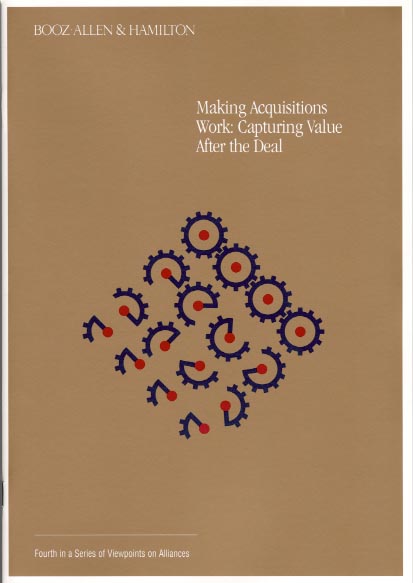Viewpoints
on Strategic Alliances
Making Acquisitions
Work: Capturing Value After the Deal (1999)
 By John
R. Harbison, Albert Viscio and Amy Asin
By John
R. Harbison, Albert Viscio and Amy Asin
This Strategic
Alliances Viewpoint, the fourth in a series, explores the challenges
and fundamental principles of success involved in capturing the
value after a merger or acquisition. An overview of recent merger
activity is provided, highlighting the increasing importance
of a successful merger capability, along with the notably low
success rate of PMI efforts to date. The discussion also summarizes
BA&H's 1997 PMI best practices survey, identifying ten of
the sixty best practice elements that distinguish how successful
and unsuccessful companies approach integration. BA&H's post-merger
integration transformation framework is then presented in detail.
Mergers
and acquisitions have become an essential element of corporate
strategy in almost every industry, as companies compete in the
race to access new markets and add critical capabilities. Worldwide,
the value of mergers & acquisitions in 1998 neared $2.5 trillion,
a 50 percent increase from the previous year. Yet fewer than
half of these mergers succeed, and the failure is usually due
to inadequacies in post-merger integration, rather than to any
fundamental weaknesses in the strategic concept.
In order
to achieve the transformation required for successful post-merger
integration, BA&H applies a "V-A-L-ue" framework,
which encompasses three key elements - Vision, Architecture,
and Leadership - implemented through careful Understanding and
Execution. In simplest terms, the V-A-L represent the what, how,
and who of the two key phases of PMI:
Mastering
the mechanics - being able to integrate the two companies in
order to achieve the stated merger objectives - by planning in
detail from the outset, identifying sources of value and how
to capture them, managing the challenges of cultural change,
and ensuring expert leadership
Meeting
the strategic leadership challenge - being able to identify,
enhance, and leverage the unique capabilities of the new entity
to maximize profit and growth - by creating a new vision for
the company to lead its industry or compete in a new way going
forward
Both phases
are described in detail from within the V-A-L-ue framework, supported
by examples from recent PMI experiences in a range of industries.
During
the throes of integration, companies often focus exclusively
on the mechanics of putting the two companies together, never
moving on to address the question at the center of the strategic
leadership challenge: How will the newly consolidated company
compete and thrive going forward? In contrast, BA&H's approach
emphasizes the strategic leadership challenge as the key to long-term
post-merger success. Ultimately, a comprehensive process, encompassing
both phases, as well as the three core V-A-L-ue components, is
essential, since shortcuts can actually destroy value.
|

